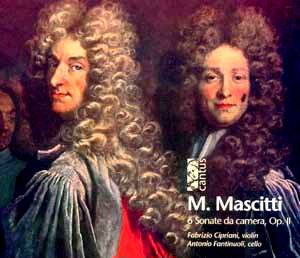 |
Michele MASCITTI (1663/4-1760) 6 Sonate da camera op. II Sonata 1 in D major Sonata 2 in d minor Sonata 3 in g minor Sonata 4 in B flat major Sonata 5 in G major Sonata 6 in C major Antonio Fantinuoli, cello Rec: November 1994, San Bartolomeo church, Cravasco, Genoa, Italy. AmazonUS Amazon recommendations |
Michele Mascatti, who lived a remarkable 96 years, spent more than half of his life in Paris. While his music bears certain similarities to that of Corelli, it is undeniable that he was greatly influenced by French music as well. These sonatas, published in 1706, bear the clear sound of Italian music, though; he had only been living in France for a few years, at the time, and the Corellian influence is omnipresent.
While these sonatas were undoubtedly written for violin and basso continuo (that is, harpsichord and cello), Fabrizio Cipriani and Antonio Fantinuoli, founders of the period orchestra Europa Galante, have chosen here to record them in a much more Spartan manner, for violin and cello alone. This gives the pieces a totally different sound - more intimate, more personal - that enhances the harmonic and contrapuntal interplay between the two instruments.
One can hear, in some of the movements, that the French influence is apparent - the choice of movements such as sarabandes, gigues and allemandes shows Mascitti's adoption of French forms. But many of the other movements bear such names as adagio, allegro and presto, much closer to the Italian style of sonatas.
The slow movements, such as the sarabande of the first sonata, are very melodic, with a simple exposition of a theme that is developed against a background of a rhythmic walking bass line. The music here is similar to most works of the time, in AABB form, the second part of each section being a more elaborate and ornamented version of the first. Violinist Cipriani uses very tasteful ornaments, and has excellent tone. This is not virtuoso music, but one can easily hear that it requires a special sensitivity to play well.
Most of the movements are not very long - between about 2 and 3 minutes - with the exception of the corrente of the third sonata, which is just over 5 minutes long. This movement is much more developed than the others, and, standing at the center of the sonata, is the centerpiece of this particular piece. It features more intricate melodies than many of the other movements, yet, at the same time, focuses on the melody rather than any technical difficulties. Its bittersweet sound is delightful, and the musicians use just the right balance between restraint and flamboyance. They are reserved when necessary, but do not hesitate to express themselves fully at times.
This is a strange disc, one that grows on the listener. The first time I listened to it, I had to adjust to the unique sound; subsequently, I was able to focus more on the music and melodies. It is quite a mellow disc; none of the music is very lively, but one is easily absorbed by it.
A strange, yet fascinating recording of some very intimate sonatas by a little-known contemporary of Corelli. While one may need to listen to this disc several times to appreciate it, it is indeed worth the effort. An interesting discovery.
Kirk McElhearn